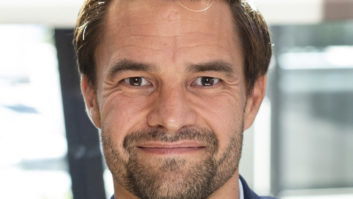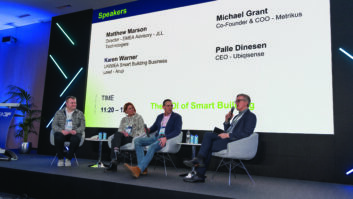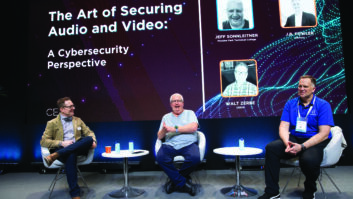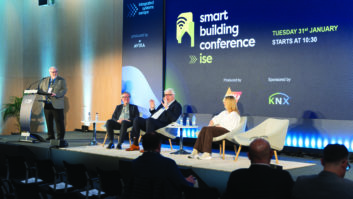
The second instalment of the Smart Building Conference took place at Dexter House in London last month. Organised by Integrated Systems Europe, the event covered the developing smart building market from various angles, bringing together the worlds of AV, building automation, security, electrical and IT system design and installation.
A key message arising from the day was that the market is an immature one; integrators need to work hard to establish a foothold in a market peppered with different technologies and stakeholders.
First to give a keynote address was Dr Steven Fawkes, chairman of Day One Energy Solutions, which develops and finances energy-efficiency solutions. His address was entitled ‘Only Eleven Percent’ – which refers to the world’s overall efficiency in converting primary sources into useful energy. He used statistics to paint a picture of a world vulnerably dependent on fossil fuels. One startling statistic was that the global population falling within the middle-class bracket will be 3 billion by 2030, leading to an exponential increase in energy usage over that time.
He made it clear that it is manufacturers’ duty to make “cool” products to counteract the perception that saving energy is boring and to entice customers into using energy-efficient technology. As an example he cited the Philips Hue system, which allows users to measure light levels in environments they admire and use these readings to create similar light levels in their living space.
In the second keynote – ‘The Battle for the Smart Building’ – Jeremy Towler (pictured), senior manager of energy and smart technology at building services research organisation BSRIA, discussed the different elements involved with smart buildings and how it was important to merge these applications and systems. The existing market for building automation and control systems (BACS) is under threat from multiple emerging systems and technologies such as Cloud-based BACS solutions, new software applications, intelligent heating controls and even variable refrigerant flow (VRF) BACS systems. “It’s a crowded space and everyone is trying to get a piece of the market,” commented Towler.
The analytics available through these systems can be leveraged and raw data collected, presented and analysed so to make better, more energy-conscious decisions. For this, he highlighted the need for a common network for all IP-based systems, because wireless LAN solutions are enabling greater data capture in buildings.
Integrators also need to be aware of the shift from IT-based products to services, which is being driven by BYOD trends.
What also emerged was a lack of customer awareness of the products currently on the market. There is a need to make the products known and he addressed how products could get to market through systems manufacturers and, for residential markets, systems integrators.
The panel discussion on ‘Future Visions of Intelligent Buildings’ brought together InfoComm International’s chief sustainability officer Allen Weidman; Quentin Drewell, who is smart buildings lead at Accenture; Matt Dodd, education director at CEDIA Region 1; and Jeremy Fawkes once more. A question was raised about building owners being reluctant to invest heavily for long-term savings because of concerns about ROI. The panel pointed out the availability of grants and ‘free money’ initiatives for these projects. It is down to the integrator to sell the technology to the building owner, they said. The overall feeling was that integrators need to focus on being businessmen rather than hobbyists, installing confidence in to prospective clients with numbers and watertight proposals. Education was highlighted as a major factor in this. Dodd made it apparent that integrators should be looking at their products and services from an energy-efficiency point of view rather than as luxury items.
John Melchin of FSR talked about ‘Building Information Modelling in Action’. BIM is a method by which all the data about the different elements in a building – such as HVAC, fire alarm systems, lighting, communications and more – are combined into a single three-dimensional model. This approach offers benefits from a building’s construction phase well into its occupancy, when it becomes a kind of “digital owner’s manual”. “BIM gets systems to work together synergistically,” said Melchin – pointing out that it can often prevent expensive errors from being made.
BIM is growing in popularity: its use is mandatory in certain US states, and in US government projects. There are moves for BIM standards to be adopted in other countries, including the UK, France, the Netherlands and Australia.
Rafel Borek of KNX Shop gave a short presentation about the role of the integrator as a project engineer, then took part in a panel discussion about buidlng automation protocols alongside Zoltan Karpathy of BSRIA, Matt Dodd of CEDIA and InfoComm’s Allen Weidman. One of the questions addressed was the iplications of China just having ratified KNX as its building control standard. This was felt to be a good opportunity for the KNX protocol and for manufactuers of KNX-based equipment (despite the fairly closed nature of the Chinese market); however, it seemed likely that it would also lead to Chinese-produced KNX equipment appearing on the European market.
In the final session, Rick Holland of the Technology Strategy Board gave a presentation about sources of UK government funding for smart building projects. A new competition – aimed at helping to develop energy management products that will be on the market in the next three to five years – has just opened, with a fund of £4 million. Applications from consortia are now being sought. It is likely that 20-30 schemes will be invited to make a detailed submission, with around half of these ultimately receiving a share of the fund.
The TSB has other sources of funding: innovation vouchers, which support micro, small and medium-sized companies wanting to work with external experts; and Smart grants, which support projects at key stages – proof of market, proof of concept, and development of prototype.
Looking back over the day, some key points emerged:
• Making buildings smart requires huge amounts of data, which need to be generated, analysed and acted upon with as little human intervention as possible.
• The market is immature, fragmented and regionally diverse.
• Energy efficiency is a key driver in the developing smart building market. Rising energy prices, scarcer fuel sources, energy legislation and regulations, and the increasing importance of corporate social responsibility are all factors here
• However, smart buildings are about more than just energy efficiency – although there are no widely agreed definitions of the term
• The AV world needs to create its own opportunities in this marketplace. After all, companies in other sectors will be looking to do the same thing
The next Smart Building Conference will take place in Amsterdam on 3 February, the eve of the ISE 2014 exhibition.
Editor’s note: A fuller review of the conference will be published in the November issue of Installation.
www.smartbuildingconference.com







